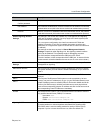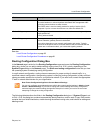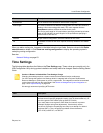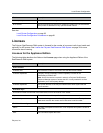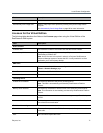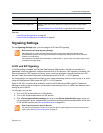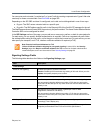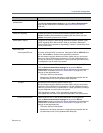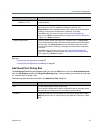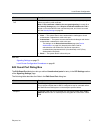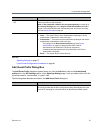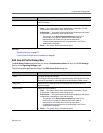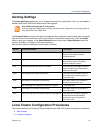
Local Cluster Configuration
Polycom, Inc. 74
You can route such untrusted (“unauthorized” or “guest”) calls by creating a separate set of “guest” dial rules
used only for these untrusted calls. See Dial Rules on page 239.
Depending on the SIP SBC and how it’s configured, such calls can be distinguished in one of two ways:
● By port: The SBC routes untrusted calls to a specific port.
● By prefix: The SBC adds a specific prefix in the Request-URI of the first INVITE message for the call.
The RealPresence Access Director SBC supports only the prefix method. The Acme Packet Session Border
Controller SBC can be configured for either.
In the SIP Settings section of the page, you can add one or more ports, prefixes, or both for untrusted calls.
For each entry, you can specify whether authentication is required. Calls to an untrusted call prefix follow
the authentication setting for that prefix, not for the port on which they’re received. For port entries, you can
also specify the transport, and if TLS, whether certificate validation is required (mTLS).
Signaling Settings Fields
The following table describes the fields on the Signaling Settings page.
Note: Require Certificate Validations for TLS
If Allow certificate validation skipping for encrypted signaling is turned off on the Security
Settings page, then Require certificate validation for TLS is turned on for both authorized and
unauthorized ports, and it can’t be turned off. See Security Settings on page 50.
Field Description
H.323 Settings
Enable H.323 signaling Enables the system to receive H.323 calls.
Caution: Disabling H.323 terminates any existing H.323 calls. When you click
Update, the system prompts you to confirm.
Status Indicates whether the system’s H.323 gatekeeper functions are active.
H.225 port Specifies the port number the system’s gatekeeper uses for call signaling.
We recommend using the default port number (1720), but you can use the
same value as the RAS port or any other value from 1024 to 65535 that’s not
already in use.
RAS port Specifies the port number the system’s gatekeeper uses for RAS
(Registration, Admission and Status).
We recommend using the default port number (1719), but you can use the
same value as the H.225 port or any other value from 1024 to 65535 that’s not
already in use.
H.245 open firewall ports Shows the port range used for H.245 so you can configure your firewall
accordingly. This is display only.
H.323 multicast Enables the system to support gatekeeper discovery (GRQ messages from
endpoints) as described in the H.323 and H.225.0 specifications.




